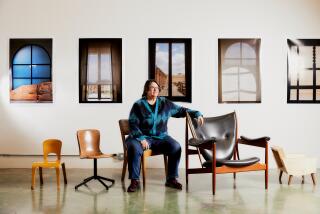FURNISHINGS : History’s Been Putting Up With Footstools
- Share via
It’s evening. Dan Rather is on the tube, droning out the day’s events. The daily paper surrounds you. With your feet up, you are relaxed, content after a vicious eight hours on the job.
Then a voice smashes your peace: Get your feet off the coffee table!
You curse the modern decor with its glass barricades and sleek nothingness. Where does one put one’s feet these days? On the dog’s back?
A footstool, hassock, ottoman--whatever they are called--you need one!
You never saw Ozzie Nelson or Ward Cleaver without one back in the ‘50s. With legs stretched out, a feeling of approachable authority was imparted--allowances were doled out, report cards signed, dating problems solved.
Footstools became trendy back in both Ancient Greece and the Byzantine Empire, when stools of many shapes and sizes were constructed to match the throne of a king or self-important local magistrate.
Usually made of bronze or iron and inlaid with African ivory, they could be folded up and carried by a servant or thrown into the back of a chariot to be transported to that afternoon’s gladiator event.
By the 17th Century, the footstool concept had trickled down to the common everyday rich folk in the form of a “gout stool.” Then, gout was considered a rich man’s ailment. The gout stool was a means of elevating throbbing feet for relief and protection.
But despite the questionable class assignments that determined who should and should not own a footstool, the times themselves dictated the need. Early Shaker settlers and Pilgrims used them because they kept their feet off cold, drafty floors and closer to toasty fireplaces.
In fact, it was during this early Colonial period when the three-legged footstool evolved. Three legs balanced better than four on uneven floors of cobble, rough brick or earth. Eventually, these stools found their way into barns because they were easy to get under milking cows.
As furniture became more sophisticated, so did the footstool. With intricately designed wood inlays and embroidery and elegant brocades, they are the treasure of the most fortunate and persevering of those who frequent flea markets and antique shops.
Some are even luckier.
“My grandmother left me two beautiful footstools when she died,” says Tom Myers of Baltimore. “One is hand-embroidered with a floral theme; the other has a wood top inlaid with silver. To me, they are priceless possessions.”
The terms footstool, ottoman and hassock are often used interchangeably, but there is a basic distinction.
* A footstool is the most stripped-down version and is generally made of the softer woods, like apple, pear or sycamore.
* An ottoman can be part of a sectional couch and is rather large, having been developed at a time when the daybed was popular.
* Hassocks are footstools used to store things, and for this reason are more boxlike, with either no legs or very short legs or wheels.
“My hassock is the perfect ploy for fast tidying,” says Tom Kiefer of Tampa. “(If) I know someone is going to drop by, it’s a great place to hide magazines, clothing and even small animals.”
Because footstools are going to house your junk and hold your feet, they’d better be sturdily made.
The Bauhaus ottoman from Canada is 26 inches square and 15 inches high and comes in a variety of fabrics and colors. There is a 100% nylon version that gives superior wear with a high degree of shape retention. Or you can select a 90% cotton, 10% polyester covering that has a better look than nylon and is resistant to wrinkles and sunlight. It retails for about $180.
The Bernhardt ottoman, from North Carolina where much American furniture is made, is larger than the Bauhaus at 32 inches square. It is covered with 100% Herculon, a tough fabric, and is on wheels for movability. The Bernhardt costs less than $300 and features a removable top cushion for cleaning and can be used with a couch to form a chaise.
Both the Bauhaus and the Bernhardt have spring construction within their bases and paddings made of polyurethane and Dacron. Their interior frames are fashioned from kiln-dried wood to thwart splitting and warping. All joints are doubled-doweled, glued, screwed and corner-blocked for maximum strength.
Heavy construction is essential for ottomans so that they can withstand the use and abuse of children who use them to watch TV and adults who grab them for stepladders.
The ultimate ottoman, however, is part of a reclining chair set designed by an orthopedic surgeon from Norway.
Called the Stressles chair and ottoman, it is heralded as one of the world’s most comfortable chairs because it gives the back and legs more natural support. But with an $800 price tag, you may opt to put your feet back up on the coffee table and hope no one yells at you.


